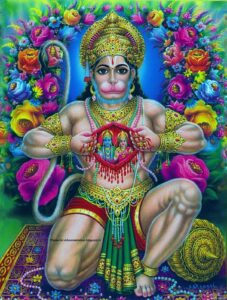Post By: Vishwanath Iyer Published on: December 16, 2016 Reading time: 5 minutes
Bhakti–yoga is the technique of transferring the sense of identity (asmitā) from ourselves to an external object such as a personal deity (iṣṭadeva), Guru/ master or teacher.
As a result, there is conscious and unconscious merger of the personality of the practitioner into that of the deity, or Yoga.
What is important here is that we must personify the deity with values that are ideal to us. This allows easy surrender and our own evolution into that vision.
Kirtana (praising the achievements of the deity) – here, we extol the diety with qualities of specific behavioural patterns which we then imbibe and make our own. One of Bhārat’s greatest bhakti proponents of the kirtana was the great princess-saint Meera who merged with Śrī Kṛṣṇa. Enclosed is one of her bhajans (kirtana of a specific format) from the movie Meera, sung by the late M. S. Subbalakshmi.
 Smarana (retaining an image of the deity at all time) – this element has two parts;
Smarana (retaining an image of the deity at all time) – this element has two parts;
One of the biggest role models of this kind of worship is Hanumān who looked for Rāmā in everything.
In society, this is used extensively – nations use flags, companies use brands and logos. However, such transferences are transient, to the extent of building and retaining a bond for a specific purpose. Bhakti-yoga requires diffusion of identity that is deeply sublime.
In society, this can mean any service that is rendered in the spirit of sacrifice (without selfish interest)
Leaders and dictators around the world often use this technique to become larger than life – Mao Zedong was venerated just as the Beatles. Even the Kim family of North Korea have entered the consciousness of every North Korean.
Bhakti-yoga an intrinsic part of the gurukula form of teaching in Oriental societies. Here, the yogi or student stays with the teacher and slowly imbibes verbal as well as non-verbal teaching during the residency through service. So, when the student leaves the gurukula, he or she has subsumed his or her psyche below that of the guru or teacher.
There is a famous story in the 1950’s regarding the 2 famous Quality Guru’s Deming and Juran when they were invited to Japan for training the Japanese on Quality. Many of the delegates were found trying to mimic Deming and Juran in their walk, talk and eating styles. Their intent was to imbibe the character of these masters completely, to the extent of their personality.
Example – Gora-kumbhar was a Maharashtrian saint potter who experienced complete integration with Panduranga Vittala (an avatara of Śrī Kṛṣṇa). Once, when he was preparing clay for his pot, he went into complete sublimal integration with the Absolute and did not notice that his child had fallen into the clay that he was ponding with his feet (watch the video here).
There are many examples of bhakti-yoga in India such as Meerabai, Chaitanya Mahaprabhu etc.
Importantly, the object of bhakti can be a deity, person, an entity such as country or even a concept such as environmental protection or archaeology.
Unfortunately, if the influence of the master overwhelms the aspirant, it can damage the practitioner. Also, it can also result in the formation of a cult or a society dominated by a master.
Internal Tags: Dharma (conditioning), Stress and Situational Awareness, Stress and prana, Awareness measures, Bhakti Yoga fundamentals, Jnana Yoga, Karma Yoga, Hatha Yoga and Raja Yoga.
External Tags: Bhakti Movement in India